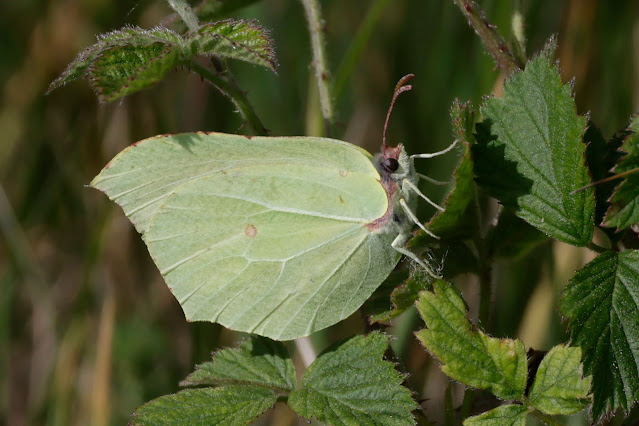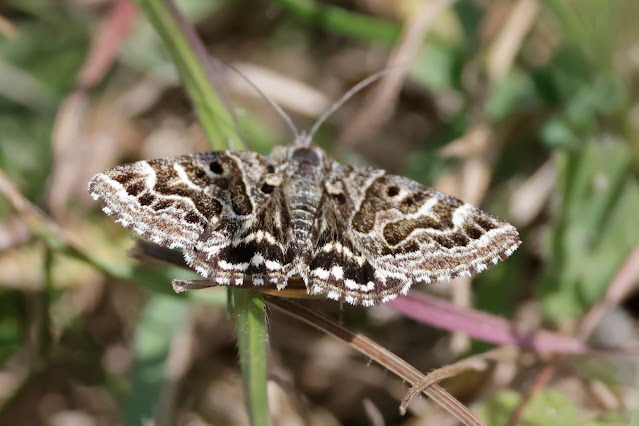A beautiful morning in May and I was at Martin Down. I have visited several times this year in the winter, but it is this time of year when this reserve comes into its own, and this year it was interesting to see the affect of the lack of rain over the last couple of months.
I set off from the car park walking along the left hand side as you look away from the car park. A Yellowhammer was singing from a bush. You don't see too many of these and the Corn Bunting at this time of year, they become more abundant as we move into June.
I was listening for bird song as I walked and it didn't take long to hear the purring song of a Turtle Dove. Once a specialty here at Martin Down, over the last few years they have become harder to see. A tall Ash tree used to be good place to find them and here today was one singing in the tree.
The dove though was not easy to see, but it suddenly burst into the air and flew around displaying before heading back to the cover of the Ash tree.
I could hear another calling from the copse a further on down the path and soon was able to locate the owner of the call at the top of a dead tree in the centre of the copse.
Fortunately the heat haze had't got up yet and the images were some of the best I have taken of this special dove.
There are lots of theories relating to the decline of this summer visitor, shooting in the Mediterranean islands, loss of suitable breeding habitat, and the lack of available water. Talking to the rangers later they confirmed there are four pairs in this area, and they were hopeful more would return.
On nearby Cranbourne Chase there has been work with the farmers to try and ensure suitable habitat. That isn't the case here at Martin, but it was confirmed that they have created ponds that are suitable for the doves and that they will be creating more around the reserve. However it was expressed that there never was water when the doves were in good numbers here, so it is a bit of mystery.
It was just lovely to get some great shots for once.
As I photographed the Turtle Dove, there were several Small Heath on the ground and in fact this was probably the most numerous butterfly on the day.
I walked up the hill and it was the usual wonderful scene looking down the hill towards the copse where the Turtle Dove had been singing.
On reaching the dyke my first Adonis Blue of the year.
There were several spikes of the greater Butterfly Orchids all around the area.
But only one out in bloom, but then it is early.
I set off along the path, today was all about butterflies and orchids, a chance to catch up on the early emerging species I have yet to see this year.
A male Brimstone in the dyke.
And a Common Blue amongst the grass, nectaring on trefoil.
Red insects flying around turned out to be Five Spot Burnets.
I turned and walked up the Jubilee path hoping to find Spotted Flycatchers, they were absent but I did flush a pair of Red Kite from the trees.
Back to the dyke and I carried on my way. A Green Hairstreak flew up out of the grass, another first for the year.
Whenever I am here there is always something in the landscape. Here the dry conditions of the reserve and grassland contrast with the highly watered and fertilised cereal crop beyond.
Then the first Marsh Fritillary, another target species. This one was a little worn out.
More Adonis, their blue flashing brightly in the sunshine.
Then more Marsh Fritillaries, these in much better condition.
This one kept flying amongst the grasses and settling in the stems.
There were plenty of Small Blue in the usual place where another footpath crosses the dyke. They were chasing each other around and settling on the grass stems and the leaves of the bushes.
The special orchid found here is the the Burnt Tip, very much a chalk species and one that normally does well here. However this year it looks as if the drought has had an impact and there was only one in flower and that was very stunted, very much like the Green-winged Orchis we saw earlier in the spring.
Hopefully they will return again in better numbers next year.
Walking on there were some day flying moths that frequent the grasslands, the Burnet Companion.
Brimstone females were flying around the small blackthorn bushes looking to lay their eggs.
Another moth, this is a Mother Shipton Moth.
I walked up to the firing Ranges and searched the area where Ian and I had Frog Orchid last year. There wasn't any sign and talking to the rangers they would expect to see them in about the second week of June. Compensation was in a the presence of a Small Copper, another first for the year.
In the middle of the field was another Green Hairstreak, a really stunning butterfly with the metallic green underwing.
I mentioned earlier that the Corn Bunting are not in their high numbers here until June when they start to breed, there were a few singing though, the bird throwing the head back as it delivers its jangling song.
I made my way back to the car, walking along the dyke at first where there were a few Common Spotted Orchids coming out.
A pair of Brown Argus were mating in one of the small hawthorn bushes.
As I approached the car a Painted Lady flew up in front of me and settled briefly on the grass. Was this to be the first of maybe an Painted Lady year? There were certainly quite a few in Crete last week.
I walked back up the slope from the car park, I was looking for Grizzled Skipper and this area had always been a good one for them and I duly found one.
If you wanted to see the affect of the lack of rain here was a good example. The area that is white has been grazed recently, that beyond has been left and is a better green. One wonders that when the rain eventually comes will there be an explosion of wild flowers and colour?
I walked back down the hill and a couple of Brimstone were dueling over the path.
Then at the car park a Yellowhammer was singing from the hawthorn bushes.
Martin Down always delivers, whether it is the scenery or the wild life. Today some great views of the Turtle Doves and the chance to get all the targeted butterflies. The only concern is the Burnt Tip Orchids, lets hope they can recover.













































No comments:
Post a Comment